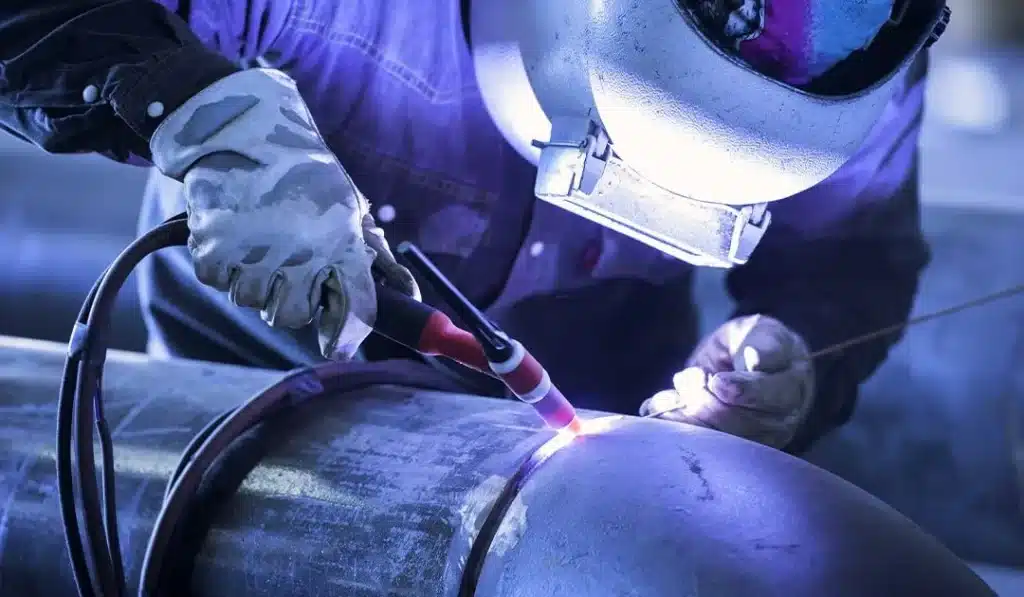To have any welding skill in life is useful, and a big plus if you are looking for a job. If you want to make a career out of your welding skill then somewhere down the line it would be best to learn TIG welding, TIG welders are the highest-paid welders, especially in industries where they would do welds on pipes and stainless alloys.
TIG welding, also known as Gas Tungsten Arc Welding (GTAW), is a fascinating welding process that requires a high level of skill and precision.

With its ability to produce clean and accurate welds, TIG welding has become a popular choice in industries such as aerospace, automotive, and even art. However, with the demand for TIG welders on the rise, and so, many are beginning to consider it as a career path. In this article, we’ll explore the TIG welding career from A to Z, including the skills, and training required to become a TIG welder, the job outlook, and what you can expect from a career in TIG welding.
What Does A TIG Welder Do?
Definition: TIG welders are skilled professionals who specialize in the Tungsten Inert Gas welding process, commonly known as TIG welding or GTAW.
TIG welding is a technique that utilizes an electric arc between a tungsten electrode and the metal being welded, while a shielding gas, typically argon or helium, is used to protect the weld area from contamination.

A TIG welder’s primary responsibility is to perform high-quality welds using the TIG welding process. This includes reading and interpreting blueprints, selecting the appropriate welding materials, setting up the welding equipment, and performing the welding process itself. TIG welders must have excellent hand-eye coordination and the ability to use welding tools and machinery with precision.
How To Become A TIG Welder?
Becoming a TIG welder requires a combination of technical skills and training. Here’s a step-by-step guide on how to become a TIG welder:
- Step 0: Have a steady hand and decent eyesight, a big plus if you are a perfectionist.
- Step 1: Obtain a High School Diploma or Equivalent
To become a TIG welder, you’ll need at least a high school diploma or equivalent. Some employers may require additional education, such as an associate’s degree or bachelor’s degree in welding technology or a related field.
- Step 2: Complete Welding Training
There are various welding training programs available, ranging from vocational schools to community colleges and technical institutes. These programs can take anywhere from a few months to two years to complete, depending on the level of education. We have a list of welding schools located across the United States, so you can choose the best one based on the program, requirements, costs, and many more.
- Step 3: Gain Hands-On Experience
After completing a welding program, it’s essential to gain hands-on experience to refine your skills. Look for apprenticeships or entry-level welding jobs to gain practical experience in TIG welding. Most welding schools will grant you an apprenticeship program to help you get started in the world of welding.
- Step 4: Obtain Welding Certification
Welding certification is not a legal requirement but is highly recommended for TIG welders as it demonstrates their competency in the craft. The American Welding Society offers various certification programs that are recognized by employers in the welding industry. Passing a certification is not mandatory, but a certified welder has a higher chance of getting a job. Keep in mind that some of the highest-paying jobs will require certification.
- Step 5: Maintain Ongoing Education and Training
To stay competitive in the job market and keep up with the latest welding techniques and technologies, ongoing education and training are crucial. Attend workshops, seminars, and conferences related to welding, and keep up with industry publications to stay informed. 6G welding pass, stainless TIG welding, welding persisted chambers… Job openings will sometimes look for specific skills you can only get through constant improvement.
Essential Skills For TIG Welders
Most TIG welder jobs are looking for TIG welders who possess a combination of technical skills and soft skills. Here are some of the top skills that employers look for in TIG welders:
- Technical Skills: TIG welding requires a high level of technical skill and precision. Employers look for TIG welders who can read and interpret blueprints, select appropriate welding materials, set up and maintain welding equipment, and perform the welding process itself with accuracy.
- Attention to Detail: TIG welding requires a high degree of attention to detail to ensure that the welds are clean, accurate, and meet industry standards. Employers look for TIG welders who have excellent hand-eye coordination and can work with precision.
- Communication Skills: TIG welders need to communicate effectively with other team members and clients. Employers look for TIG welders who can listen actively, convey information clearly, and collaborate with others. Also, welding in general is a competitive trade, expect that your pears will act accordingly
- Problem-Solving Skills: TIG welding can present various challenges, such as working with complex materials, tight spaces, or time constraints. Employers look for TIG welders who can think creatively, troubleshoot problems, and find effective solutions.
- Safety Awareness: TIG welding involves working with hazardous materials and equipment. Employers look for TIG welders who prioritize safety and follow all safety protocols to prevent accidents and injuries.
Duties and Responsibilities of TIG Welder
TIG welders are responsible for producing high-quality welds using the Tungsten Inert Gas (TIG) welding process. They work with a variety of metals and alloys, including carbon steel, mild steel, stainless steel, aluminum, and copper, to create welded parts for various industries such as aerospace, automotive, and construction.
Before beginning the welding process, TIG welders need to install equipment and prepare the materials by cleaning and removing any contaminants such as rust, oil, or dirt using brushes and hand tools.

They also need to cut, shape, and fit the materials to the correct specifications and engineering blueprints. Once they read the blueprints, TIG welders can set up and maintain their welding machines and equipment to ensure that it operates effectively and safely. They need to select the appropriate welding machine, filler material, and gas, and adjust the settings based on the job types and materials they are welding.
After completing the welding process, TIG welders need to inspect and test the welds to ensure that they meet industry standards and specifications. They use various tools such as X-ray machines, ultrasonic testers, and visual inspections to check the quality of the weld.
TIG welders need to maintain a safe working environment by following all safety procedures and using appropriate personal protective equipment (PPE). They need to ensure that their welding area is free of any flammable materials and that they have proper ventilation. TIG welders need to collaborate with other team members, such as engineers, designers, and quality control specialists, to ensure that the welded parts meet the required specifications.
Risks of TIG Welding Career And Working Environment
Like any job that involves working with machinery and hazardous materials, there are some risks associated with a TIG welding career. Additionally, the welding environment for TIG welders can include working in extreme weather conditions. Here are some of the potential risks that TIG welders should be aware of:
- Exposure to Harmful Fumes and Gases: TIG welding produces fumes and gases that can be harmful to the welder’s health if inhaled. Welders should work in a well-ventilated area and wear appropriate respiratory protection to minimize exposure to these fumes and gases.
- Eye and Skin Damage: The bright light produced during TIG welding can cause eye damage if proper eye protection is not used. Welders should wear a welding helmet with a shade rating suitable for TIG welding. Skin damage can also occur if the skin is exposed to ultraviolet radiation during the welding process. Welders should wear protective clothing and apply sunscreen to exposed skin.
- Electrical Shock: TIG welding uses high-voltage electrical arcs, which can cause electrical shock if the welder comes into contact with live electrical parts. Welders should wear dry gloves and boots and ensure that their welding equipment is properly grounded to minimize the risk of electrical shock.
- Burns and Fires: Welding produces high heat, which can cause burns if the welder is not wearing appropriate protective clothing. Welders should wear flame-resistant clothing, gloves, and boots to protect against burns. The high heat produced during welding can also ignite nearby flammable materials, so it’s essential to keep the welding area clear of flammable materials.
- Repetitive Motion Injuries: TIG welding involves repetitive motions of the hands and arms, which can lead to repetitive motion injuries such as carpal tunnel syndrome. Welders should take frequent breaks and stretch to minimize the risk of these injuries.
TIG Welder Salary
The expected TIG welder salary can vary depending on several factors, including welding experience, location, industry, and skill level. According to the Bureau of Labor Statistics (BLS), the median annual wage for welders, cutters, solderers, and brazers, which includes TIG welders, was $22.60 per hour or $47,010 per year. According to ZipRecruiter, the average annual pay for a TIG Welder in the United States for 2023 was approximately $19.97 an hour, or $41,539 a year. This is the equivalent of $798/week or $3,461/month.

However, TIG welders are in demand in a variety of industries that require their specialized welding skills. Electric Power Generation, Transmission, and Distribution can earn you an annual mean wage of up to $92,130. This is the highest-paying industry for welders, but the job requirements will require more than 5 years of experience and certification in handling and performing all welding processes, equipment, and inspection.
You can find advertisements for jobs in industries such as Pipefitting or Nuclear welding that will pay more than $100.000 a year. With added bonuses and overtime work (more than 40 hrs a week), you can even reach $150.000. Boiler welders with 5-7 years of experience can make an average of $62,000 and $82,600.
Benefits Of TIG Welder Jobs
A career in TIG welding can offer good pay, job security, opportunities for advancement, and a chance to use creativity and craftsmanship in their work.
TIG welding is a specialized skill that is in high demand in many industries, including aerospace, automotive, construction, and manufacturing. This demand for skilled TIG welders means that job opportunities are often plentiful, a job search is easier and can offer long-term security.

TIG welding is a skilled trade, and as such, TIG welders can expect to earn a good wage. This career offers opportunities for advancement, including becoming a welding supervisor, inspector, or instructor. With experience and additional training and certifications, TIG welders can progress in their careers and increase their earning potential. TIG allows welders to create unique and intricate designs. Welders can use their creativity to design and fabricate custom parts and structures that are both functional and aesthetically pleasing.
TIG welding can be used to work on a variety of materials, including stainless steel, aluminum, copper, and brass. This versatility allows welders to work on a variety of projects and can provide a diverse and interesting career.
Role Of TIG Welders In Various Industries
TIG welders play an essential role in ensuring the quality and safety of the products and structures they work on. TIG welders play a crucial role in many industries, including aerospace, automotive, construction, and manufacturing.
TIG welding is used extensively in the aerospace industry to create high-quality, precision parts that meet strict safety and quality standards. In the automotive industry, TIG is used to weld exhaust systems, roll cages, and other custom parts. GTAW is used in construction to TIG weld stainless steel and other metals for architectural and structural applications.
Is TIG Welding Career Worth The Risk?
Whether a TIG welding career is worth the risk depends on the individual’s personal situation, goals, and priorities. Like any career, TIG welding jobs have their risks and benefits, and it is up to the individual to weigh them and make an informed decision.
TIG welding offers a fulfilling career that can provide good pay, job security, opportunities for advancement, and a chance to use creativity and craftsmanship in their work. Many TIG welders enjoy the sense of pride that comes with creating something from scratch and seeing it come to life. MIG and TIG welding is common welding work choices. However, MIG welding processes are considered easier, but they are less rewarding. MIG weld
Conclusion
TIG welding is a specialized skill that requires a combination of technical knowledge, practical experience, and artistic creativity. TIG welders play an essential role in many industries, including aerospace, automotive, construction, and manufacturing.
While there are risks associated with the job, TIG welding can be a fulfilling and rewarding career, offering good pay, job security, opportunities for advancement, and a chance to use creativity and craftsmanship in their work. So get on your certification, and wait for the job alert.




